A recent study published in Aging Cell has uncovered promising insights regarding postoperative cognitive impairment, particularly in older adults. Researchers have identified Nogo-66 receptor 1 (NgR1) as a potential therapeutic target to alleviate cognitive decline associated with surgery.
Cognitive Implications of Surgery
Postoperative cognitive dysfunction (POCD) and postoperative delirium (POD) are common neurological complications following surgical procedures. These complications, collectively referred to as postoperative neurocognitive disorders (pNCDs), are particularly prevalent among older patients, posing significant challenges for mental recovery after surgery. Evidence suggests that inflammation plays a critical role in the development of these cognitive issues, although the underlying mechanisms remain poorly understood.
Role of Nogo-66 Receptor 1 (NgR1)
This research highlights NgR1, a receptor known for its role in restricting neuroplasticity, as a significant factor in cognitive decline. Neuroplasticity is essential for memory formation and learning, yet NgR1 has been implicated in various cognitive impairments, including difficulties in forgetting distressing memories stemming from childhood trauma. Additionally, NgR1 has been linked to the propagation of Alzheimer's pathology in animal models.
Mechanism of Action
The study investigated the impact of surgical stress on NgR1 levels in the hippocampus of aged mice (20-22 months). Following surgical intervention:
- Increased NgR1 Expression: Levels of NgR1 were found to be significantly elevated in the hippocampus, though not in other brain regions.
- Behavioral Changes: Mice exhibited increased anxiety, indicated by behaviors such as heightened marble-burying and reduced exploration of open spaces.
- Intervention with NEP1-40: Administration of a peptide antagonist to NgR1 mitigated these anxiety levels, normalizing relevant behaviors.
Neuroprotective Effects of NEP1-40
The administration of NEP1-40 not only eased anxiety but also provided synaptic protection. In surgical mice, synaptic activity, as measured by the protein PSD95, was significantly reduced:
| Group | PSD95 Levels | Behavioral Anxiety Score |
|---|---|---|
| Surgery | Decreased | Increased |
| Surgery + NEP1-40 | Normal | Normal |
| Control | Normal | Normal |
Impact on Neuron Structure
Changes were also observed in the dendritic structure of CA1 pyramidal neurons within the hippocampus:
- The number of mature dendritic spines was reduced in surgical mice compared to controls.
- Administration of NEP1-40 reversed this loss, restoring spine density and function.
- Alterations in the ratio of F-actin to G-actin further elucidated the mechanisms of neuroplasticity affected by surgery.
Implications for Aging and Neuroplasticity
The findings from this research underscore the importance of addressing NgR1 as a potential target to enhance neuroplasticity and cognitive recovery in the elderly. Prolonged neuroplasticity challenges are well-documented across various scenarios, not limited solely to surgical contexts. If interventions targeting NgR1 prove successful, they may facilitate learning and memory retention in older adults, particularly following significant surgical procedures.
Next Steps and Future Research
Further investigations are required to explore:
- Drug discovery efforts to develop specific NgR1 inhibitors.
- The long-term efficacy of NEP1-40 in diverse patient populations.
- Other potential neuroprotective strategies that could complement this approach.
Conclusion
By understanding the mechanisms behind postoperative cognitive dysfunction, researchers can pave the way for interventions that target neurocognitive health, fostering improved outcomes for older patients after surgery.
Literature Cited
[1] Alam, A., Hana, Z., Jin, Z., Suen, K. C., & Ma, D. (2018). Surgery, neuroinflammation and cognitive impairment. EBioMedicine, 37, 547-556.
[2] Jin, Z., Hu, J., & Ma, D. (2020). Postoperative delirium: perioperative assessment, risk reduction, and management. British Journal of Anaesthesia, 125(4), 492-504.
[3] Akbik, F. V., Bhagat, S. M., Patel, P. R., Cafferty, W. B., & Strittmatter, S. M. (2013). Anatomical plasticity of adult brain is titrated by Nogo Receptor 1. Neuron, 77(5), 859-866.
[4] Bhagat, S. M., Butler, S. S., Taylor, J. R., McEwen, B. S., & Strittmatter, S. M. (2016). Erasure of fear memories is prevented by Nogo Receptor 1 in adulthood. Molecular Psychiatry, 21(9), 1281-1289.
[5] Wang, J., et al. (2021). Nogo receptor impairs the clearance of fibril amyloid-β by microglia and accelerates Alzheimer’s-like disease progression. Aging Cell, 20(12), e13515.
[6] Zhao, Y., et al. (2017). Amyloid beta peptides block new synapse assembly by Nogo receptor-mediated inhibition of T-type calcium channels. Neuron, 96(2), 355-372.
[7] Toyoizumi, T., et al. (2014). Modeling the dynamic interaction of Hebbian and homeostatic plasticity. Neuron, 84(2), 497-510.
[8] Diering, G. H., & Huganir, R. L. (2018). The AMPA receptor code of synaptic plasticity. Neuron, 100(2), 314-329.
[9] Gu, J., et al. (2010). ADF/cofilin-mediated actin dynamics regulate AMPA receptor trafficking during synaptic plasticity. Nature Neuroscience, 13(10), 1208-1215.
[10] Lifespan.io














Discussion